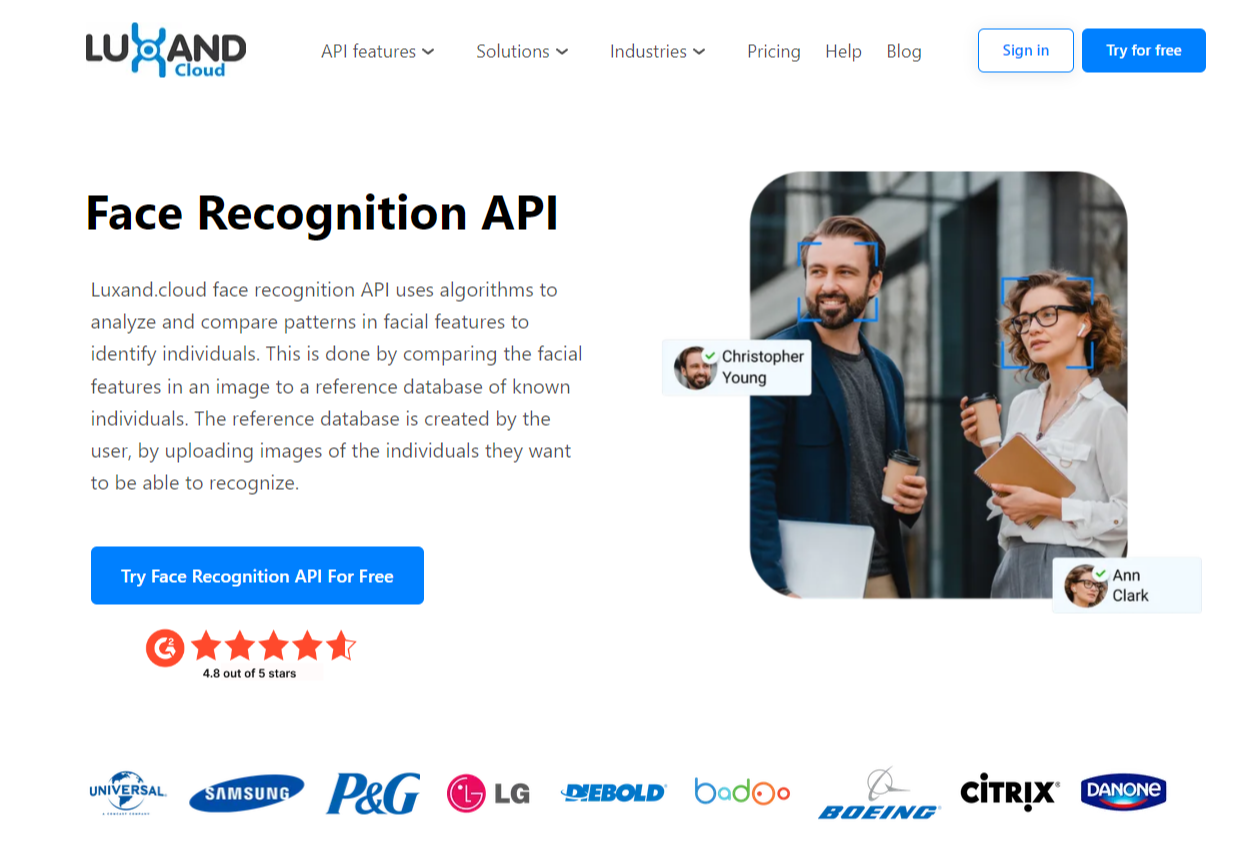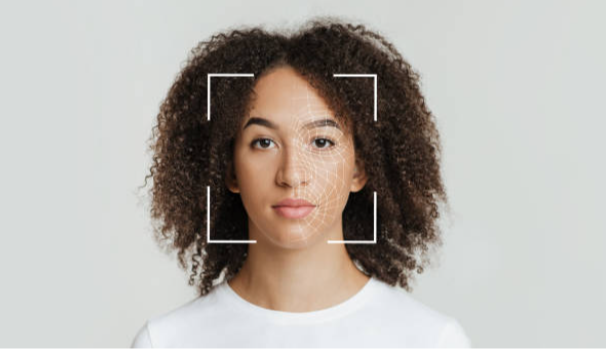
Top Face Recognition APIs in 2024
As facial recognition technology advances, the range of APIs available in 2024 offers sophisticated solutions for integrating face detection and analysis into various applications. From enhancing security systems to personalizing user experiences, face recognition APIs have become essential tools for developers and businesses seeking to leverage this powerful technology.
In this post, we’ll explore some of the top face recognition APIs of 2024, each providing unique features and capabilities. Whether you’re looking for advanced detection accuracy, comprehensive facial analysis, or seamless integration with other services, these APIs represent the cutting edge of facial recognition technology. Join us as we delve into the functionalities and benefits of these leading APIs, helping you make an informed choice for your next project.
Luxand.cloud Face Recognition API

Luxand.cloud's Face Recognition API is a versatile tool that allows users to integrate powerful facial recognition capabilities into their applications effortlessly. The API is built to perform a wide range of tasks, including face detection, recognition, and tracking. Whether you're developing security systems, social media apps, or customer engagement platforms, Luxand's API provides the necessary features to enhance user experiences through seamless facial analysis.
Luxand.cloud offers more than just a face recognition API; it provides a range of additional APIs with diverse functionalities. Explore the various APIs below to learn more about the comprehensive solutions Luxand.cloud offers.
Face Detection and Recognition
The core functionality of Luxand.cloud's API lies in its ability to accurately detect and recognize faces in images or video streams. It can identify individual faces even in complex scenarios, such as varying lighting conditions or partial occlusions, making it highly reliable for real-world applications.
Facial Landmarks and Attributes
Beyond simple face detection, the API can identify and analyze over 70 facial landmarks, such as the position of eyes, nose, and mouth. This capability is crucial for applications that require detailed facial analysis, such as emotion detection or facial animation.
Age and Gender Detection
Luxand.cloud's API also includes features to estimate the age and gender of detected faces. These features can be particularly useful in demographic analysis, targeted marketing, and user personalization, allowing businesses to tailor their offerings more effectively.
Emotion Recognition
Understanding a user's emotions can significantly enhance the interactivity of an application. The API can recognize a wide range of facial expressions, enabling apps to respond dynamically to users' moods, which can be applied in areas like customer service or entertainment.
Ease of Integration and Documentation
Luxand.cloud prioritizes ease of use, providing extensive documentation and code samples to help developers quickly integrate the Face Recognition API into their projects. The API supports various programming languages, including Python, Java, and C#, making it accessible to a wide range of developers. The clear and detailed documentation ensures that even those with minimal experience in facial recognition can implement the API effectively.
Luxand.cloud offers flexible pricing plans that cater to different business needs, whether you're a small startup or a large enterprise. The API is designed to scale effortlessly, handling everything from a few hundred to millions of API calls per month. This scalability ensures that as your business grows, the API can grow with you, without compromising performance.

Amazon Rekognition API
Amazon Rekognition, a service offered by Amazon Web Services (AWS), provides a comprehensive and versatile face recognition API designed to meet the needs of modern applications. This API enables developers to integrate advanced facial recognition capabilities into their software with ease, offering powerful tools for detecting, analyzing, and identifying faces in both images and videos. As facial recognition technology becomes increasingly important across various industries, Amazon Rekognition stands out for its ability to deliver accurate and reliable results in a wide range of use cases.
The API’s core functionality includes the ability to detect and recognize individual faces, making it an essential tool for applications such as security systems, identity verification, and personalized user experiences. Additionally, Amazon Rekognition offers detailed facial analysis, allowing users to assess attributes like age, gender, and emotional state. This level of analysis can be particularly valuable for businesses looking to understand their audience better or tailor services based on demographic data.
What sets Amazon Rekognition apart is its integration with the broader AWS ecosystem, which ensures scalability and ease of use. The API is backed by robust documentation and support, making it accessible to developers regardless of their experience level. With its flexible pricing model and strong security measures, Amazon Rekognition is a reliable choice for businesses of all sizes looking to leverage face recognition technology in their applications.
Learn more here: Comprehensive Guide to Amazon Rekognition: Features, Benefits, Use Cases, and Alternatives
Microsoft Azure Face API
The Microsoft Azure Face API offers a range of key features that make it a powerful tool for facial recognition applications. At its core, the API excels in face detection, capable of identifying and locating faces within images and videos with high accuracy. This foundational capability ensures that users can effectively incorporate face recognition into their systems, whether for security, customer interaction, or other purposes.
One of the notable features of the Azure Face API is its ability to perform detailed facial analysis. The API can assess various attributes, including age, gender, and emotional expressions, providing valuable insights into individuals' demographics and sentiments. This feature enhances user engagement by enabling more personalized experiences and targeted interactions based on analyzed facial data.
Additionally, the Azure Face API supports face verification and identification. It can compare faces from different images to confirm whether they belong to the same person, a function commonly used in authentication and security applications. This capability is crucial for applications requiring reliable identity verification. The API also supports facial grouping and recognition across large datasets, making it suitable for applications that need to manage and analyze extensive collections of facial images efficiently. Overall, these features make the Microsoft Azure Face API a versatile and effective solution for integrating facial recognition into various applications.
Learn more here: Face Recognition API: Luxand.cloud vs Microsoft Azure Face API
Google Cloud Vision
Google Cloud Vision provides a sophisticated Face Recognition API designed to integrate advanced facial analysis capabilities into applications. As part of Google Cloud’s suite of machine learning tools, this API offers robust features for detecting and analyzing faces within images. It is well-suited for a range of use cases, from enhancing user interactions to supporting security measures and content moderation.
The core functionality of the Google Cloud Vision Face Recognition API includes detecting faces and identifying facial attributes with high accuracy. The API can locate faces in images, even in complex settings or varying lighting conditions, and assess attributes such as emotions, age range, and facial expressions. This detailed analysis enables applications to tailor user experiences, perform sentiment analysis, and enhance demographic insights.
Additionally, Google Cloud Vision’s API supports facial detection in images with a focus on scalability and ease of integration. It is designed to work seamlessly with other Google Cloud services, making it a flexible choice for developers working within the Google ecosystem. With its strong emphasis on performance and accuracy, the Google Cloud Vision Face Recognition API provides a valuable tool for integrating facial recognition technology into diverse applications and services.

Face++
Face++, a prominent player in the facial recognition technology space, offers a range of key features through its Face Recognition API that cater to various application needs. At the forefront is its ability to detect and identify faces within images with high precision. This foundational capability enables users to accurately locate and recognize individuals in diverse scenarios, whether for security purposes, user verification, or content tagging.
One of the standout features of the Face++ API is its comprehensive facial analysis. It provides detailed insights into facial attributes such as age, gender, and facial expressions. This functionality allows applications to go beyond mere face detection, offering a deeper understanding of user demographics and emotions. Such detailed analysis can enhance user interaction by enabling personalized experiences based on the attributes and sentiments identified through facial data.
In addition to face detection and analysis, Face++ offers robust facial recognition and verification capabilities. The API can match faces across different images to determine if they belong to the same person, which is essential for identity verification systems and access control. Moreover, Face++ supports large-scale face recognition, allowing applications to manage and analyze extensive databases of facial images efficiently. These features make the Face++ API a versatile and valuable tool for integrating facial recognition technology into various applications and services.
Clarifai
Clarifai offers a Face Recognition API that provides comprehensive facial analysis and recognition capabilities. As part of Clarifai’s suite of artificial intelligence solutions, this API enables developers to integrate advanced facial recognition features into their applications with ease. Designed to handle a variety of use cases, the Clarifai Face Recognition API excels in detecting and analyzing faces within images, making it a versatile tool for enhancing user experiences and supporting various operational needs.
The API’s core functionality includes accurate face detection, which allows it to locate and identify faces in images with high precision. It goes beyond simple detection by offering detailed facial analysis, such as identifying attributes like age, gender, and emotional state. This feature enables applications to gain deeper insights into user demographics and sentiments, which can be leveraged for personalized content, targeted marketing, and more effective user engagement.
Additionally, Clarifai’s Face Recognition API supports facial recognition and verification, allowing it to match faces across different images to determine identity. This capability is essential for applications requiring secure user authentication and identity verification. With its emphasis on accuracy, scalability, and ease of integration, the Clarifai Face Recognition API is a valuable solution for developers looking to incorporate advanced facial recognition technology into their products and services.
FaceX
FaceX offers a specialized Face Recognition API that provides a range of features for detecting and analyzing faces within images. This API is designed to integrate facial recognition capabilities into various applications, supporting tasks such as identification, verification, and demographic analysis.
The FaceX API enables accurate face detection, allowing it to locate and recognize faces in images with high precision. It includes features for analyzing facial attributes, such as age, gender, and expressions, which can be useful for applications that require detailed demographic information or emotional insights. This functionality supports a variety of use cases, from enhancing user interactions to conducting market research.
Additionally, FaceX’s API includes facial recognition and verification capabilities, allowing it to compare faces across different images to confirm identity. This feature is valuable for applications that require secure user authentication or access control. Overall, FaceX provides a reliable tool for incorporating facial recognition technology into applications, with a focus on accuracy and ease of use.
Kairos
Kairos provides a Face Recognition API that offers a range of functionalities for integrating facial recognition technology into various applications. The API is designed to facilitate tasks such as face detection, identification, and analysis, making it a useful tool for applications that require accurate facial recognition capabilities.
The core features of the Kairos API include robust face detection, which allows it to accurately locate and identify faces in images. In addition to detecting faces, the API can analyze facial attributes, such as age and gender, as well as recognize emotional expressions. This level of detail can be useful for applications involving user profiling, targeted content, and sentiment analysis.
Kairos also supports face matching and verification, enabling it to compare faces across different images to determine if they belong to the same person. This capability is relevant for identity verification and security-related applications. Overall, the Kairos Face Recognition API provides a comprehensive set of features for integrating facial recognition into applications, with a focus on precision and practical utility.
Conclusion
As facial recognition technology becomes increasingly integral to applications spanning security, marketing, and user experience, choosing the right API is crucial. The APIs highlighted in this overview offer comprehensive features that can be tailored to specific use cases, ensuring that developers and businesses can implement sophisticated facial recognition functionalities effectively.
Overall, the top face recognition APIs of 2024 provide powerful tools for integrating facial recognition technology into a wide range of applications. By leveraging these APIs, organizations can enhance their operational capabilities, improve user interactions, and stay competitive in an ever-evolving technological landscape.
